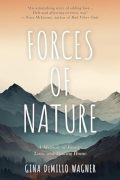Making the Personal Universal: 5 Ways to Help your Narrative Resonate with a Wider Audience
By Gina DeMillo Wagner
 When I was writing my memoir, Forces of Nature, I knew I had to do more than describe my family dynamics or chronicle the events of my life. I wanted to find points of connection with my future readers. I needed to figure out how my story was actually everyone’s story. In other words, I needed to create universality.
When I was writing my memoir, Forces of Nature, I knew I had to do more than describe my family dynamics or chronicle the events of my life. I wanted to find points of connection with my future readers. I needed to figure out how my story was actually everyone’s story. In other words, I needed to create universality.
It may sound counterintuitive, but a memoir isn’t about the author. It’s about the reader’s relationship to the author’s story. In my case, writing about the sudden death of my brother who had a profound disability became a story not only about this singular loss and its aftermath. It became a story about the concepts of family and home, about how to love and care for someone without abandoning yourself, a story about the healing power of nature, about the long-tail impacts of disability, and the joy of discovering your own voice.
The best personal narratives capture one-of-a-kind experiences and cast a light on larger themes and universal truths. They tell unique stories that millions of people might read and say, “this describes me too.” Without those echoes between author and reader, a memoir will feel myopic and self-indulgent, like a diary entry.
Achieving universality in your personal writing requires a level of self-awareness, but also empathy, intuition, and craft. Luckily, these are skills you can practice. Here are a few tips to create those points of connection and keep readers invested in your story:
It’s in the (sensory) details
One of the universal experiences we have as humans is our ability to sense the world around us. While a reader may not relate to the exact plot points of your life, most can immediately connect with sensory details like the acrid smell of smoke, the taste and feel of a ripe peach between your lips, sticky juice dripping down your chin, the sight of a tree swaying in the breeze, or the sound of tires screeching on pavement.
When you capture sensory details on the page, readers will drop into your story as if it’s happening to them too. Practice writing a scene several different ways, creating different entry points, or highlighting different senses.
Create emotional resonance
Like a piece of music that vibrates in your chest or gives you goosebumps, emotional resonance in writing sends ripples through the reader’s psyche. As a writer, you want to create clarity of tone and capture emotions authentically on the page without gushing or overwriting. In other words, you want what you write to feel true, real, and relatable. You’ll know you’ve created resonance when your readers are able to consider how and when they’ve felt the same way you did in the moment you’re describing.
With my memoir, I understood that readers may not have firsthand knowledge of growing up alongside someone with a profound disability, but many people could relate to feeling invisible or setting your own needs aside because someone else needs more. I imagined even more could identify with the quest to find your place in the world after a tumultuous childhood. And in the wake of a pandemic, nearly all of us know how it feels to grapple with unknowns and grieve something or someone we’ve held dear.
Zoom in and out
Writing personal narratives requires us to zoom in on our own experience like a photographer gazing through a telephoto lens. Yet, every so often, you’ll need to zoom out and take a wider view. How? By putting your experience in a larger context. What would an outsider say about you and your experience? Can you find perspective by interrogating yourself from a distance? How does your experience resemble others’ experiences? How is it different? How do the events of your life fit into a larger social or cultural context? Are there any takeaway lessons?
Offer Interiority
It also helps to remember that the deepest, most vulnerable parts of ourselves – the things we tend to hide – are usually the parts that connect us most authentically to others. This is true in relationships and in writing.
Most people can relate to concealing something about themselves for fear of others judging, whether it’s a deep desire, a point of shame, a secret, or regret. As a writer, don’t be afraid to paint a full picture of yourself as a character, flaws and all. Presenting only the best, most palatable parts of your character is unrealistic and will alienate your readers. Remember, even superheroes have shadow selves.
Make clear your motivation and what’s at stake
Finally, if you want to keep a reader invested in your story, let them know what you really want, what you fear, or what’s at stake in your life. What in your story (or within yourself) needs to transform or change? What obstacles are in your path?
In this way, memoir and essay writing can borrow tools and techniques from fiction. Readers will feel closer to the story when they understand the protagonist’s desires and motivations and when they have a clear picture of any antagonists in your story. If you convey that well, readers will readily join your quest, follow your coming of age, and root for you until the end.
—
Gina DeMillo Wagner is the author of FORCES OF NATURE, (May 14, 2024; Running Wild Press).Her writing has been featured in The New York Times, The Washington Post, Memoir Magazine, Modern Loss, Self, Outside, CRAFT Literary, and other publications. She has been honored with a 2024 Yaddo residency and is a winner of the CRAFT Creative Nonfiction Award, and her memoir was longlisted for the 2022 SFWP Literary prize. Gina has a master’s degree in journalism and is cofounder of Watershed creative writing and art workshops. She lives and works near Boulder, Colorado. You can visit her online at ginadwagner.com.
Forces of Nature: A Memoir of Family, Loss and Finding Home
 Gina De Millo Wagner’s brother Alan had a rare genetic disorder that caused him to veer from loving to violent. When Alan died suddenly, Gina was pulled away from the safety of her adult life and thrust back into a family she had been estranged from for nearly ten years. FORCES OF NATURE follows this rewinding of the past, exploring Gina’s caregiving journey and reckoning with complicated grief, plus Alan’s Christmas-themed funeral, and an investigation into his cause of death. It’s a personal story that asks universal questions: How much of ourselves should we sacrifice to those we love? And, what forces shape our sense of family and home?
Gina De Millo Wagner’s brother Alan had a rare genetic disorder that caused him to veer from loving to violent. When Alan died suddenly, Gina was pulled away from the safety of her adult life and thrust back into a family she had been estranged from for nearly ten years. FORCES OF NATURE follows this rewinding of the past, exploring Gina’s caregiving journey and reckoning with complicated grief, plus Alan’s Christmas-themed funeral, and an investigation into his cause of death. It’s a personal story that asks universal questions: How much of ourselves should we sacrifice to those we love? And, what forces shape our sense of family and home?
BUY HERE
Category: On Writing























